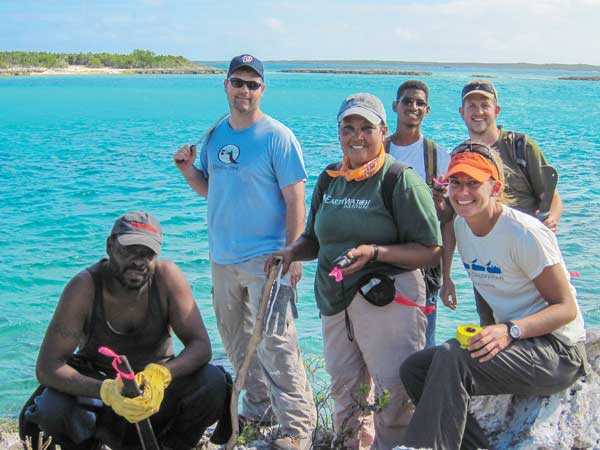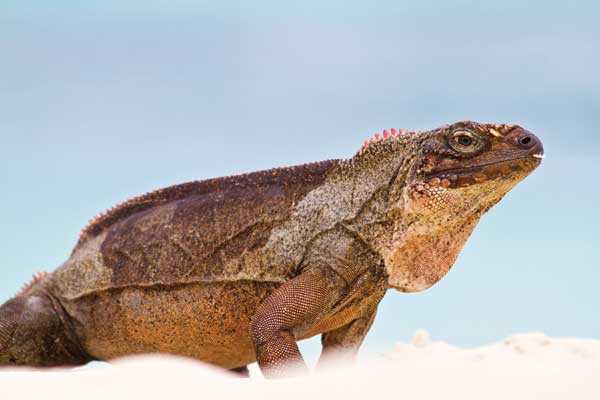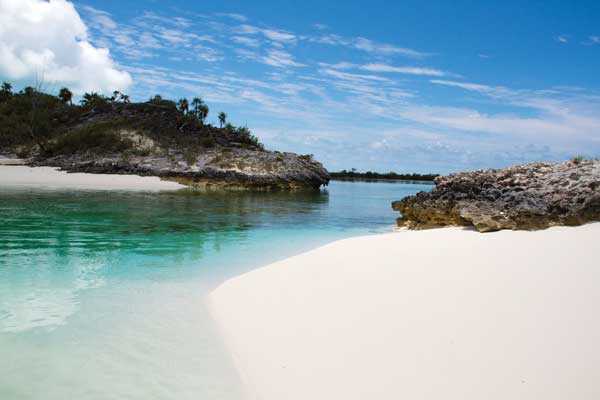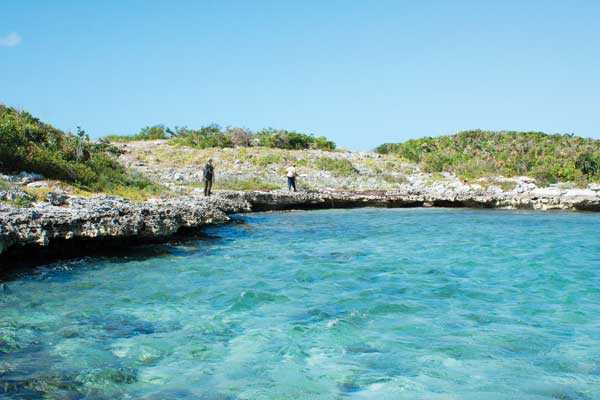Allen Cay, The Bahamas was declared free of damaging, invasive house mice today by a partnership restoring the Cay’s natural environment, seabirds, and Endangered iguanas.
“This announcement is a major milestone for the recovery of Allen Cay and for our partnership. We plan to replicate this success on other islands being damaged by invasive alien species,” said Eric Carey, Executive Director for the Bahamas National Trust (BNT). The partnership includes BNT, Island Conservation, Dr. John Iverson of Earlham College, and Dr. Will Mackin. Funding support was provided by the National Fish and Wildlife Foundation’s Recovered Oil Fund for Wildlife, and charter boat operator Powerboat Adventures and the John G. Shedd Aquarium also made significant contributions to the project.
Allen Cay supports the third largest breeding population of Audubon’s Shearwaters (Puffinus lherminieri lherminieri) in the Bahamas, as well as The Bahamas-endemic Allen Cay Rock Iguana (Cyclura cychlura inornata) listed as Endangered by the International Union for Conservation of Nature (IUCN). The inadvertent introduction of non-native house mice, a primary food source for Barn Owls, led to an artificially higher number of the transient Barn Owls which then ate large numbers of Audubon’s Shearwaters. As a result, the mortality rate for Audubon’s Shearwaters was twice as high on Allen Cay compared to nearby cays without invasive rodents. The decline of Audubon’s Shearwaters and the lack of breeding iguanas were strong indicators that the Cay’s threatened natural ecosystem required action.
In 2009, the BNT, Island Conservation, Dr. John Iverson (Earlham College), and Dr. Will Mackin forged a partnership to develop and implement plans to remove house mice from Allen Cay. To ensure and document success, the partners conducted extensive planning, field-trials, on-site monitoring, and public outreach. After careful review, The Bahamas Ministry of Environment authorized the project in April 2012. The partners then took action and implemented the removal project in May 2012.
Last week, the partnership visited the Cay, confirmed the absence of mice, and supported Earlham College scientists as they reintroduced resident iguanas that had been translocated to a nearby cay to avoid disturbance during the restoration project. The confirmation team saw early signs of a recovering island ecosystem, and preliminary findings suggest a significant drop in the Audubon’s Shearwater mortality since mice have been removed.
The Caribbean, including the Bahamas, is home to significant biological diversity, hosting nearly 8,000 species of plants and animals found nowhere else in the world. However, invasive alien species—introduced flora and fauna that disrupt the island’s natural balance and compete with or eat native plants and animals—are a leading threat to native species in this region. Globally, since 1500, 80 percent of all extinctions have occurred on islands. Some 40 percent of all animal species at risk of extinction today rely on islands. “Seabirds, iguanas, and other wildlife in The Bahamas are very sensitive to introduced plants and animals. This project and similar actions can help to reverse the declines they have experienced,” said Dr. Mackin.
The mouse-removal effort is a significant part of a larger effort to restore the natural environment of Allen Cay. Subsequent work to enhance breeding habitat will be done to increase the chance of recruitment and recovery of the iguana population. Following the removal of invasive mice, natural cavities were filled with sand to provide ideal nesting sites for female Allen Cay Rock Iguanas. Such efforts will continue into the future.
“We have just eliminated one of the biggest problems facing island iguanas today, invasive species, and now have the possibility of doubling the world’s population of the Endangered Allen Cay Rock Iguana,” said Dr. Iverson.
But there is more to be done. To ensure permanent protection of the iguanas and shearwaters, the reinvasion of invasive mice must be avoided. It is essential that recreational boaters and local fishermen understand the impacts that introduced rodents can have on these island ecosystems so they can take steps to help prevent reintroduction. To minimize the risk of reintroduction of mice, BNT will develop and implement a biosecurity plan and work with recreational boaters and fishers to reduce the risk of future invasions.
“We are excited to announce the success of this project and partnership,” said Island Conservation’s Executive Director, Bill Waldman. “The partnership has already begun to leverage this achievement into more projects to protect The Bahamas’ rich biodiversity from invasive alien species.”
Allen Cay is located in the northern Exuma Islands, approximately 60 km southeast of Nassau, The Bahamas. This karst formation is approximately 1 km long, 5 m in elevation, and 100 m wide.
[easy-social-share]



